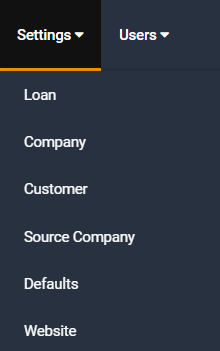Table of Contents
Introduction
When you want to edit the settings for everything you do in LMS, tenant-level settings are the place to go. These settings will affect your entire ecosystem, changing the options that will be available when creating and editing individual loans, customers, other entities.
Having said that, it's important to know what you're doing when you change these settings. A mistake at the tenant-level could create issues for countless loans. The only users who should have access to these settings should have a deep knowledge of both our software and your workflows.
What are Tenant-Level Settings?
First off, we should explain what a 'tenant' is. A tenant is your company's account with LMS. On another software, you might call this an "account" or "user," but both of those terms refer to something else in the software, so it's a 'tenant' here. Most LMS tenants correlate to a single company. Individual loans, customers, and agent users are all saved within a tenant.
Your 'tenant-level' settings, then, affect your operations across the board. When you log into LMS, you can access them through the Settings tab in the top right of the screen.

Clicking Settings opens a drop-down menu with the following options:
| Settings | What They Control |
| Loan |
We should clarify that there are both loan-level and tenant-level loan settings. The Loan Settings page will control all kinds of options affecting individual loans, but the options in Settings > Loan affect all loans across the tenant. What do tenant-level loan settings control?Here's a quick list:
|
| Line of Credit |
Much like the tenant-level loan settings described above, these settings affect all line of credit accounts. What do tenant-level line of credit settings control?There are five tabs:
|
| Company |
These settings control user access, automation engine, filters, and notifications. It's also where you'll find settings for all of your integrations. What do tenant-level company settings control?Here's a full list of company settings:
|
| Customer | Tenant-level customer options control the custom fields that will appear on each customer, as well as the labelling options for statuses, note categories, and document sections. You can also set filters based on customer age and credit score. |
| Source Company | Source Tracking are used to track either brick and mortar locations or third-party companies where loans originated (e.g., an related finance auto lender might create source companies representing individual dealerships). Source Company Tenant-Level Settings will govern their custom fields, labeling, and defaults. |
| Defaults | When you create a new loan, a customer, a transaction, or other entity, defaults can fill in most of the fields for you. None of those choices will be locked in, but having them preset can save agent users lots of time in their day-to-day servicing operations. For more information, see our category on Defaults. |
| Website | If you're using LoanPro's out-of-the-box Customer Website, this area of the settings will let you edit each page and manage the site. |
Where do Tenant-Level Settings Fit?
Tenant-level settings are how you can configure LMS to make it match your lending model. It's through these settings that you can make the system work for you. Whether you're just getting started with LoanPro, redesigning your workflows, or just fine-tuning it, we recommend working with our Success Specialists to get the most out of your configuration.
This Feature is Not
Let's clear up some possible misconceptions about tenant-level settings:
- None of these tools require custom programming. These are all built-in pieces of LoanPro's configurable infrastructure, and part of what make the platform deeply customizable and capable of handling virtually any class of financing product.
- Tenant-level settings are not a bulk edit tool. If you change the configuration and defaults in your tenant-level settings, it will affect loans that you make in the future, but it won't go back and interfere with any existing loans. (If you are looking for bulk editing tools, try Imports.)
What's Next?
From here, you're probably ready to dive into specific areas of tenant-level settings.
- Defaults let you pre-fill the fields on loans, customers, transactions, and other entities. When you create or log on of these entities, the system will pull up all of your default values, and then you can make any necessary adjustments. This is a simple way of cutting back monotonous work and saving your agent users' time.
- Preconfigured Loans let you save a template loan, and then create any number of loans based on that template. Unlike your tenant-level defaults, you can save multiple preconfigured loan templates, meaning you could create one for each of your loan products.
